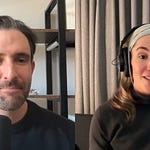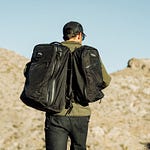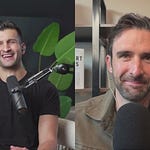Housekeeping
Full access to this post and its video and audio is for Members of Two Percent.
Members get full access to all Two Percent Wednesday and Friday posts. Become a Member below.
Thanks to our partners, who make the best products in their categories.
Momentous Nutrition: The company that made me feel good about supplements again. My picks: Essential Plant Protein + Multivitamin.
GORUCK: Maker of the best rucking gear (not stuff). My picks: Rucker 4.0 for rucking and GR1 for travel.
Maui Nui Venison: Provider of the world’s healthiest meat (the research, linked here, is insane). My picks: 90/10 Organ Blend + Sugar Free Venison Pepper Jerky Sticks.
Discount code EASTER for all brands.
P.S. I’m going to start using the Substack chat function. It’ll be a fun way for us to swap information, share tips, connect, and more.
I’ll be hosting a chat this Sunday, 10/13.
You won’t get an email about this. If you want to join (or lurk!), download the Substack app and turn on push notifications. You’ll get a notification when we go live.
Audio/podcast version
The post
Today is the second Friday of the month. Which means it’s time for Gear Not Stuff.
The concept for Gear Not Stuff is simple.
We live in a world of mass consumerism and have more stuff than ever. As I explained in my book Scarcity Brain, the average home contains 10,000 to 50,000 items.
If we want a new thing, we no longer have the pause of traveling to a store—we can buy it right from our computer, phone, TV, or even yell to Alexa.
We own too much, and curious forces are now leading us to acquire even more stuff …
Consider: Online retailers stole tactics from casinos, leading us to buy more faster. They leverage what’s called The Scarcity Loop. It’s worked on you if you’ve ever bought some crap and immediately regretted buying said crap. More on the power of The Scarcity Loop here.
When we get overwhelmed by how much we own, we often seek minimalism.
But minimalism has failed us (I covered why in Scarcity Brain). Luckily, I found a smarter way we can get more from less …
In thinking about how we can make smarter purchasing decisions, I’ve begun delineating between gear and stuff.
Stuff is a possession for the sake of it. Stuff adds to a collection of (too many) items. We often buy stuff impulsively to fix boredom or stress or to solve a problem we could figure out creatively with something we already have.
Gear, on the other hand, has a clear purpose of helping us achieve a higher purpose.
Gear is a tool we can use to have better experiences that make us healthier and give our lives meaning.
Enter Gear Not Stuff, a monthly column featuring the best gear.
This month’s Gear Not Stuff: Avoid Microplastics
Last week, we ran two posts on microplastics.
Here’s a post on microplastics and how they harm your health (six things you must know).
Long story short: Microplastics are everywhere—and they don’t seem good for our health.
But specific products can help us avoid them. Today’s Gear Not Stuff features 8 pieces of essential gear that will help you and your family take in fewer microplastics—reducing your long-term health risks. We cover these 8 items in the video above and text below.
This is important. One new and groundbreaking study discovered that 58 percent of patients undergoing heart surgery had microplastics in their heart plaque. Critically, the presence of microplastics in the heart was linked to a 4.5-fold increase in death, heart attack, or stroke.
The research suggests microplastics may also impact our brains, liver, lungs, and reproductive systems and increase our risk of certain cancers.
Of course, this is a budding field of inquiry and we need to know much more. It could just turn out that people who ingest more microplastics have all sorts of other habits that lead to their health problems.
But when the level of effort to avoid a possible harm is low, you might as well avoid it. Enter these 8 pieces of gear.
As I conducted research for this post, I found many products that claim to filter out microplastics don’t do a great job. They’re stuff.
These items work. They’re gear, not stuff.
Weigh in with your own favorite non-plastic gear in the comments. Hive mind is good thinkin’.
Let’s roll …
1. A steel water bottle + metal straw
My pick: Stanley Quencher 40oz + Metal Straws
Drinking bottled water instead of tap delivers an extra 90,000 microplastics into your body per year, according to one study.
So it makes sense to drink less plastic bottled water and instead use a refillable steel bottle.
There are a hundred options that all hold water. So you probably don’t need to overthink this. But I like the Stanley Quencher 40oz because:
I’m basic.
The water doesn’t run through a plastic mouthpiece (the top is plastic, but the water doesn’t touch it).
The 40oz size means I have enough water for a hard garage gym workout. (For the uber-thirsty, Stanley makes a 64oz version)
I drink more and avoid clumsily spilling on myself if I drink through a straw.
Note: The Stanley comes with a plastic straw, so Leah and I just swapped ours out for steel straws.
You can get a five pack on Amazon for $8. And, yes, we Leah and I do look like basic idiots walking around our home sipping from giant Stanley tumblers.
2. A water filter
My pick: Lifestraw Glass Filter
You just learned that tap water contains fewer microplastics than bottled. Good!
But tap water also contains some microplastics and other contaminants, the level depending on your local water source.
Filter if you want to be cautious.
But here’s a funny thing about filters: It’s not easy finding one that’s plastic-free. Britta, the big name in the space, is entirely plastic.
Traveler+ makes some plastic-free countertop filters. But they’re giant—seemingly built for a construction crew or football team.
I settled on a glass LifeStraw filter. The water pitcher is glass, but the filter itself is plastic. I’m OK with that, though, because the filtration reports show the product removes microplastics, suggesting no transfer.
3. Polar Seltzer water
I didn’t include this in the video above, but it’s a good one.
In a test of nine different drinks ranging from bottled water to Gatorade to Iced Tea, Polar seltzer water had the fewest microplastics—by far.
It registered zero nanograms of microplastics. All other drink brands included anywhere from 1,700 to 7,500 nanograms of microplastics.
Of course, we covered how microplastics are often a function of where a drink was bottled. So it may just have been a particularly clean day at the Polar canning plant.
But I’m just going to take this and run with it because I love seltzer water and zero is zero.











